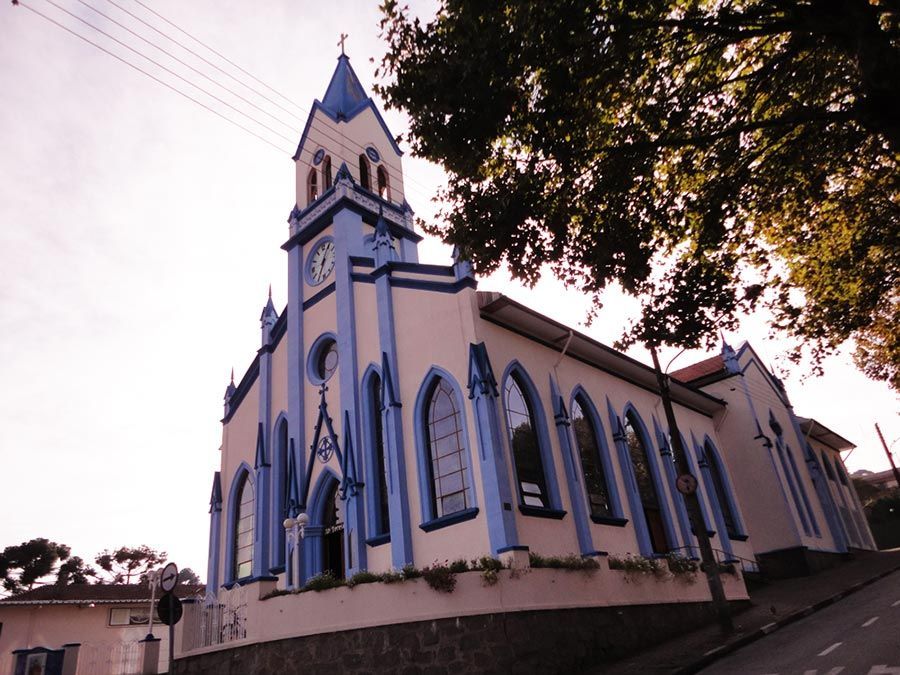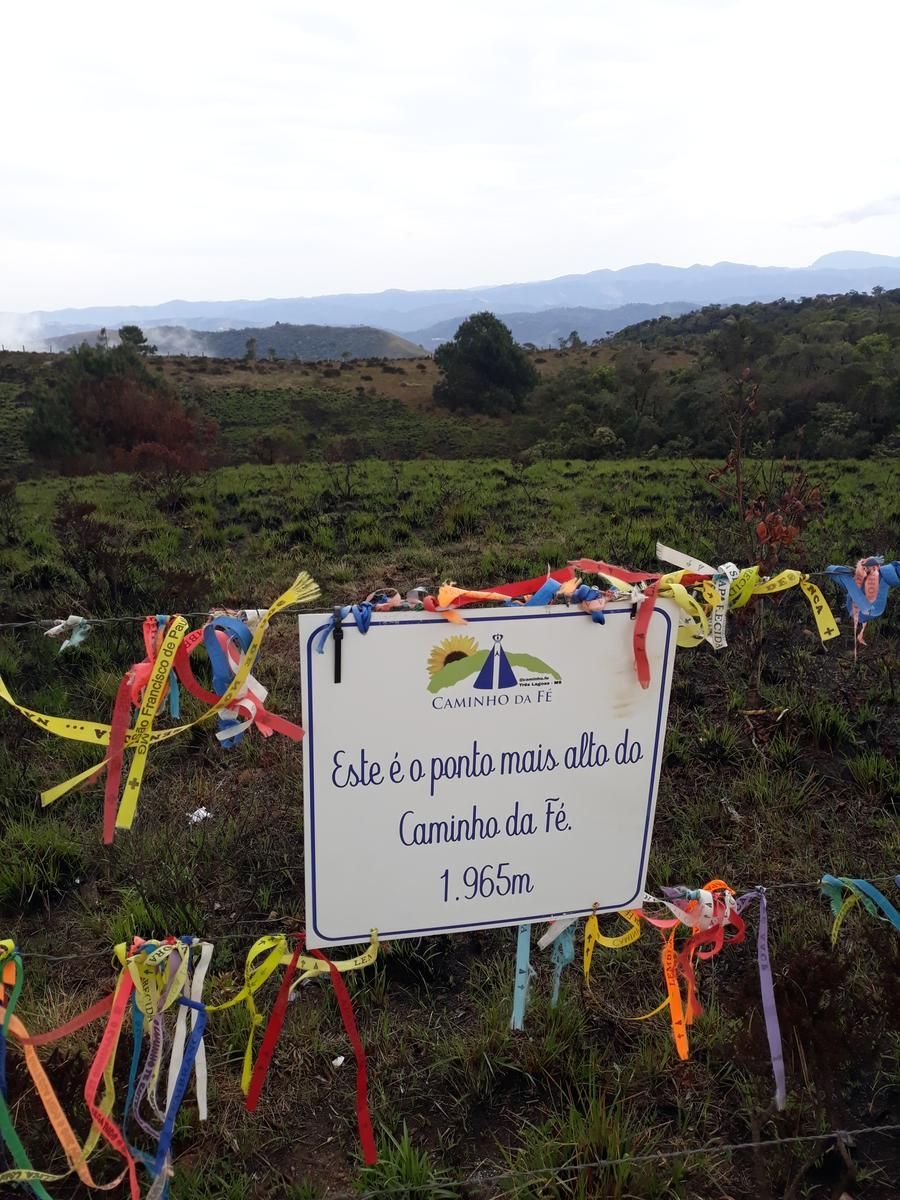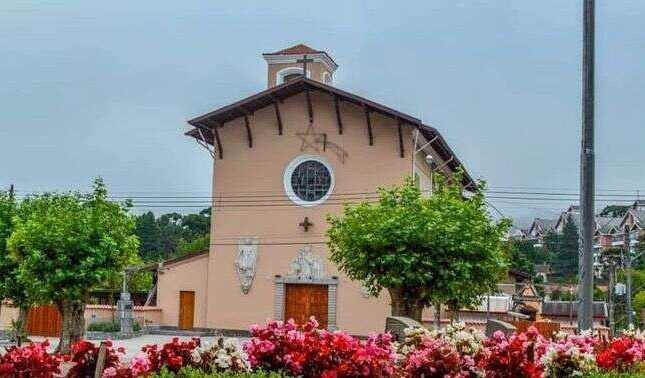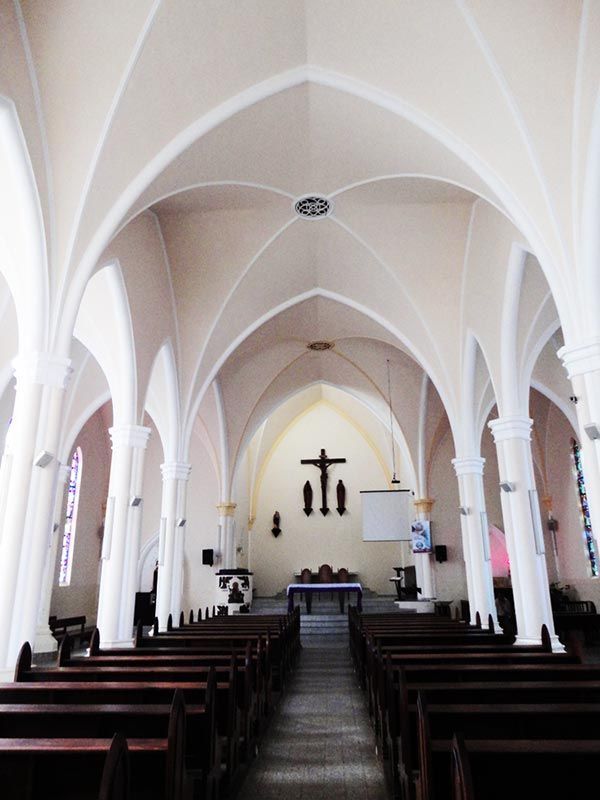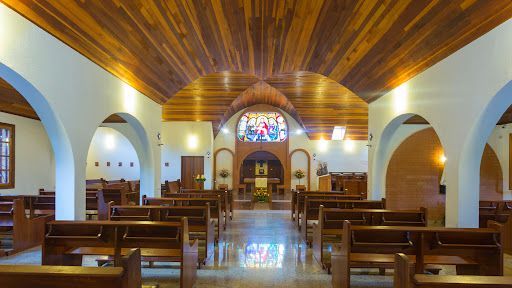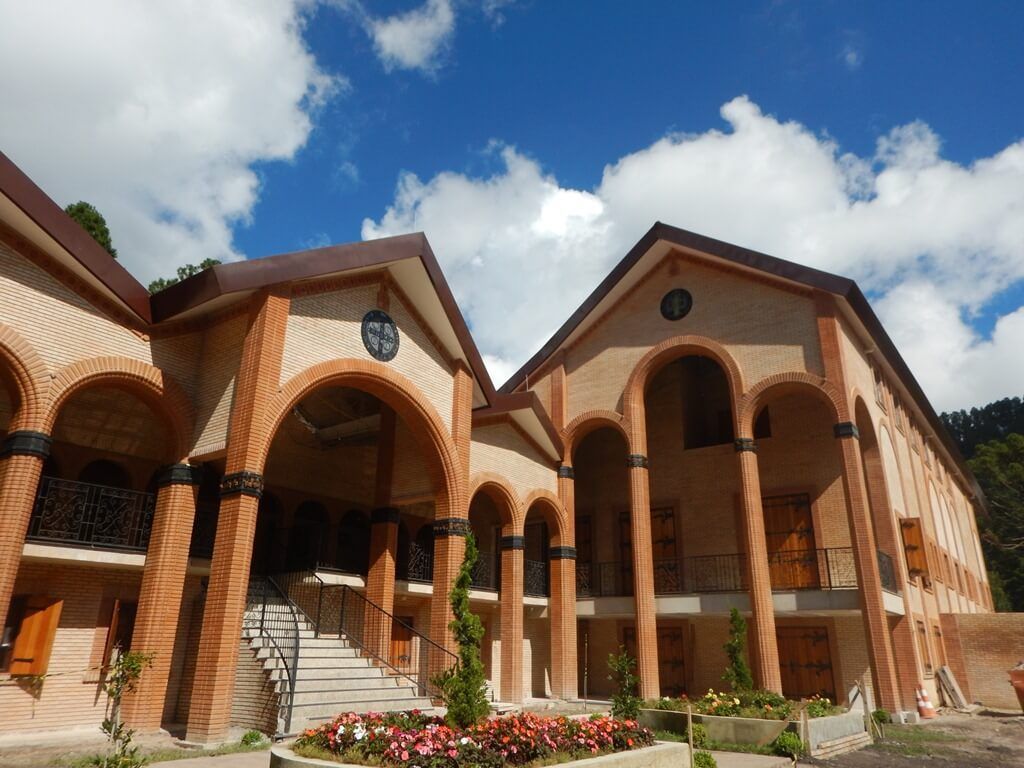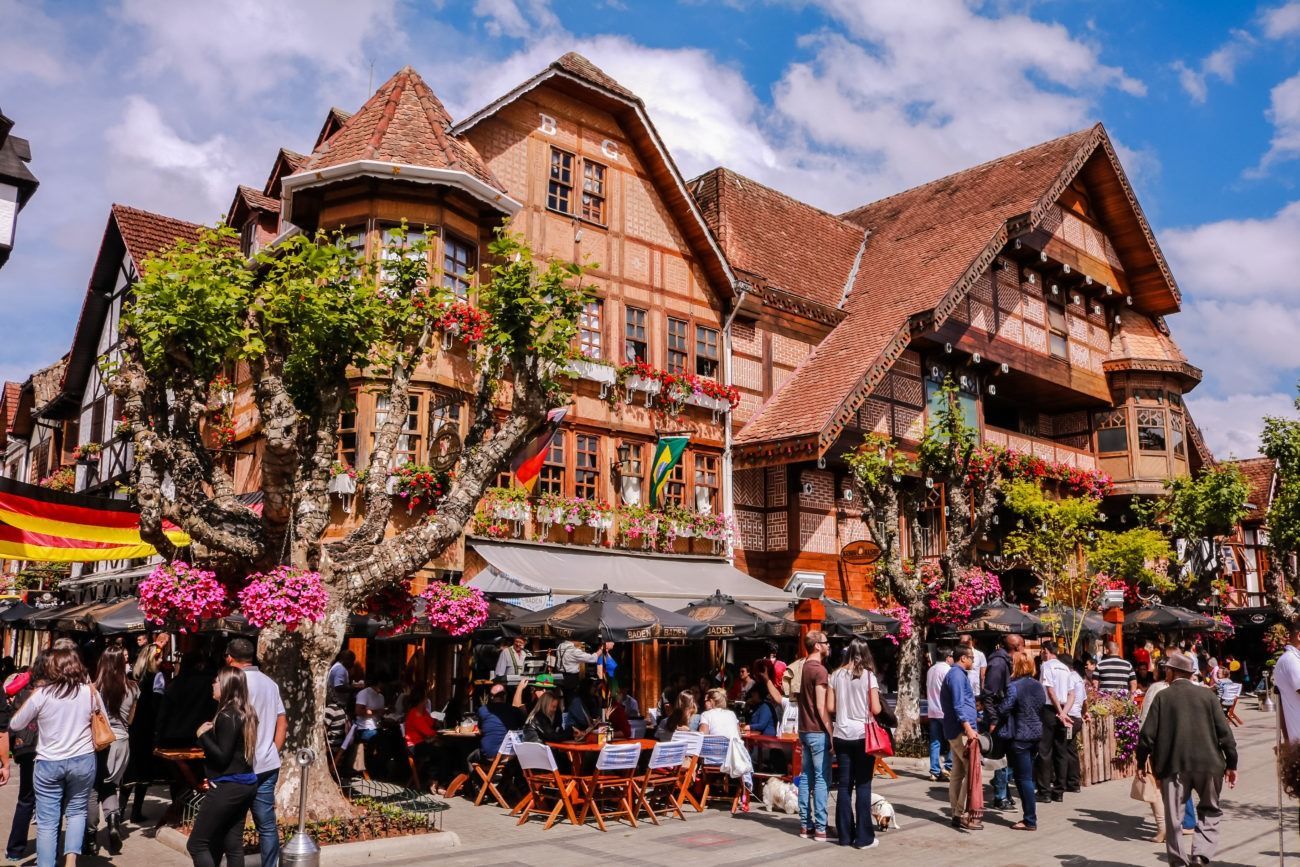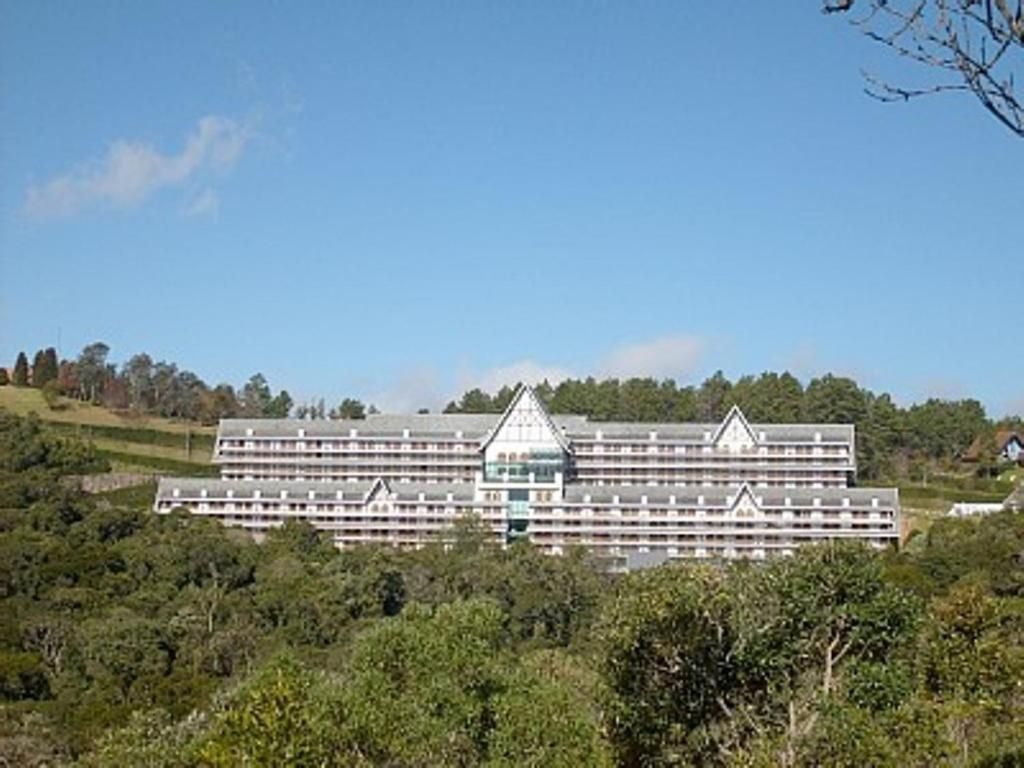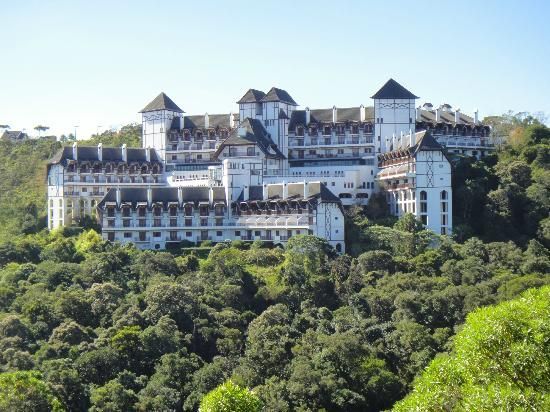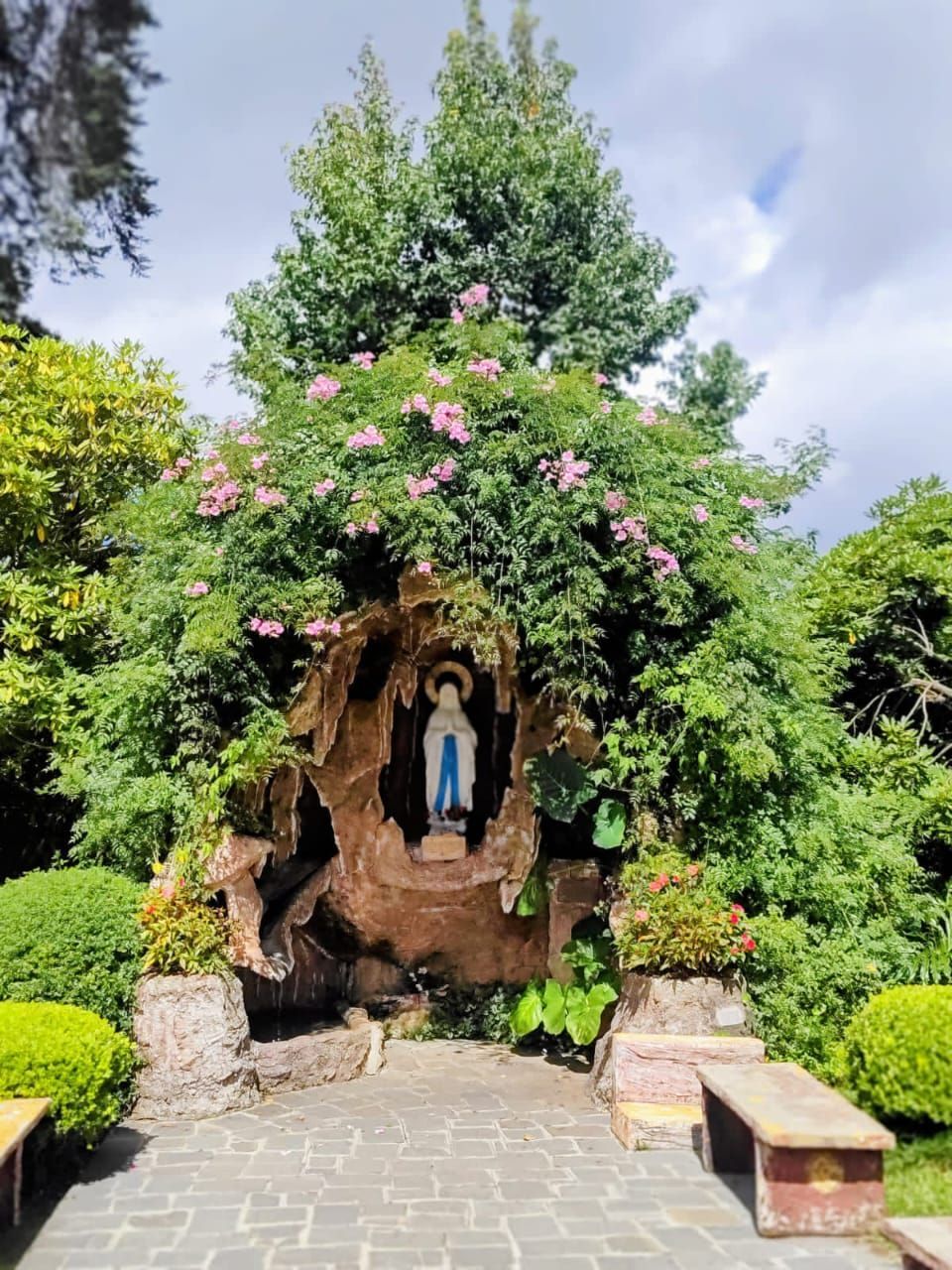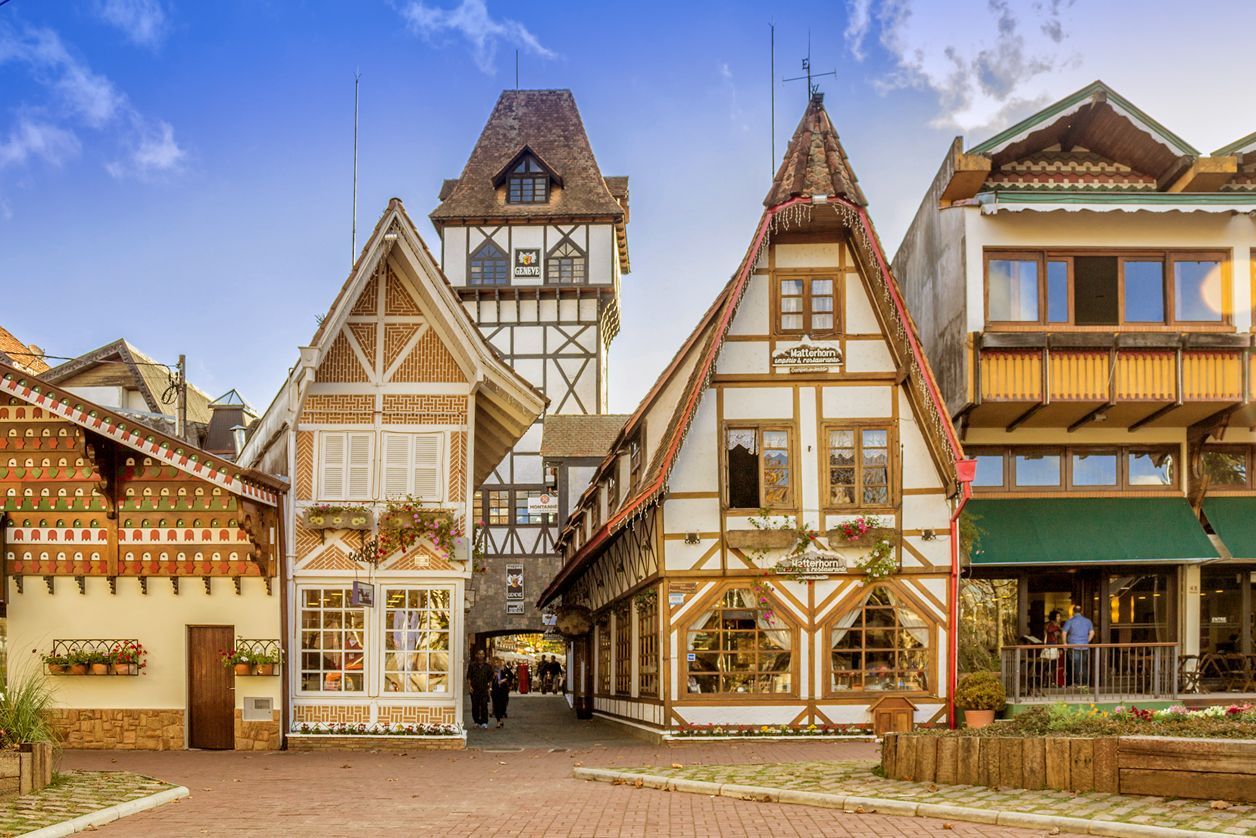Campos do Jordao - SP
On this page, the Portal Peregrino da Esperança presents the city of Campos do Jordão in the Serra da Mantiqueira, known as the Brazilian Switzerland, containing a brief description of its immeasurable beauty. The importance of the São João Monastery in welcoming and providing hospitality to pilgrims is highlighted.
🕊️ "The teacher's job is to speak and teach, the disciple's job is to be silent and listen."
Pray and Work! (Saint Benedict)
Features of the City of Campos do Jordão - SP
Campos do Jordão, located in the interior of the state of São Paulo, is a city that stands out not only for its natural beauty, but also for its unique architecture, mild climate and atmosphere reminiscent of charming European cities. Situated in the Serra da Mantiqueira, at an altitude of over 1,600 meters, it is recognized as the highest city in Brazil, which gives it a typically cold climate, attracting tourists all year round, especially in winter, when its streets are filled with visitors looking to enjoy the perfect combination of nature, gastronomy and culture. The city is surrounded by lush vegetation, composed of araucaria and pine trees and trails that invite contemplation and contact with the environment.
The history of Campos do Jordão begins in the late 19th century, when the city began to develop as a place of healing, initially sought out by people seeking treatment for respiratory diseases, especially tuberculosis. The dry, cold climate, combined with the purity of the mountain air, was essential for the city to become an important health center at the time, receiving patients from various regions of the country. Over time, Campos do Jordão's vocation changed, and it began to consolidate itself as one of the most sophisticated and sought-after tourist destinations in the state of São Paulo, without, however, losing the marks of its origins.
As you walk through its streets, it is impossible not to be enchanted by the architecture inspired by the Alpine and half-timbered styles, which make the city a piece of Europe in the heart of Brazil. Cafés, chocolate shops, restaurants and craft shops make up the welcoming and sophisticated setting, offering visitors experiences that go far beyond conventional tourism. The cultural life also stands out, especially during the famous International Winter Festival, which transforms Campos do Jordão into a stage for classical music performances, bringing together renowned artists and music lovers from all over the country.
In addition to its urban and cultural side, Campos do Jordão maintains a close relationship with nature, offering a wide range of outdoor activities, such as trails, bike rides, visits to ecological parks and viewpoints that provide stunning views of the Serra da Mantiqueira. The city, therefore, reveals itself as a destination that enchants not only for the beauty of its landscapes and the elegance of its architecture, but also for the hospitality of its people, the richness of its cuisine and its ability to provide well-being, leisure and culture in an environment where tradition and modernity meet harmoniously. Thus, Campos do Jordão continues to be one of the greatest prides of the interior of São Paulo, a place where each visitor finds not only rest, but also inspiration and enchantment.
Campos do Jordão is affectionately known as the Brazilian Switzerland, a title that was not given by chance, but rather due to the combination of characteristics that make it unique in the national scenario. Its privileged location in the Serra da Mantiqueira, at an altitude of over 1,600 meters, provides a cool and mild climate for much of the year, very similar to that found in many European cities, especially in Switzerland. This climate, combined with the typical Alpine-style architecture, with half-timbered buildings, sloping roofs and facades reminiscent of Swiss villages, gives the city an atmosphere that immediately transports its visitors to a European setting in the heart of Brazil.
The nickname Brazilian Switzerland also reflects Campos do Jordão's concern with maintaining a harmonious urban aesthetic, where the beauty of the buildings dialogues with the exuberance of the surrounding nature. The well-kept streets, the flower gardens and the constant presence of araucaria and pine trees complete the charming scenery that recalls the landscapes of the Alps. In addition to the appearance, the climate contributes significantly to this comparison, since during the winter months temperatures can reach very low levels, including records of frost and, occasionally, the rare and expected occurrence of snow, albeit in small quantities.
Being called the Brazilian Switzerland is not just a tourist slogan, but rather the recognition of an urban, cultural and environmental project that, over the decades, has known how to value its natural and architectural characteristics, creating a destination that combines elegance, beauty and quality of life. Campos do Jordão, therefore, consolidates itself as a piece of Europe in the heart of Brazil, where the perfect combination of climate, landscape, architecture and culture lives up to this title that makes its residents so proud and its visitors so delighted.
The presence of Campos do Jordão on the Águas da Prata branch of the Caminho da Fé represents one of the most emblematic and challenging stretches of the entire pilgrimage, both for its spiritual significance and for the majestic landscapes that surround pilgrims during the crossing. Located in the Serra da Mantiqueira, the city stands out not only for its unique beauty and mild climate, but also for being the point where the highest stretch of the entire Caminho da Fé is located, located on the famous Estrada das Pedrinhas. This place, with an altitude of over 1,950 meters, is not only the physical peak of the route, but also symbolically becomes one of the moments of greatest overcoming, reflection and spiritual connection for those who travel this journey.
Upon reaching Campos do Jordão, pilgrims encounter a landscape that uniquely combines the beauty of the mountains, the lush vegetation and the charm of a city that, in itself, invites contemplation and introspection. The climb to Estrada das Pedrinhas requires effort, determination and faith, as in addition to being the highest point, it is also one of the stretches that most tests the physical and emotional endurance of those who choose to follow this path. However, it is precisely this difficulty that makes the experience even more meaningful. Upon reaching the top, the reward is not only the breathtaking panoramic view, but also the feeling of overcoming, achievement and deep gratitude for the journey thus far.
Campos do Jordão, with its characteristic hospitality and welcoming structure, offers pilgrims more than just rest and shelter. It offers a space where spirituality is intensely manifested, whether through contact with majestic nature, or in fraternal encounters with residents and other hikers, or even in moments of silence and reflection provided by the path itself. The city, located in the heart of the Serra da Mantiqueira, thus becomes a place of passage that transforms, welcomes and strengthens the spirit of those seeking not only to reach their final destination, but also to fully experience each stage of the pilgrimage.
The fact that the highest point of the Caminho da Fé is located in the city of Campos do Jordão carries a special symbolism. It represents not only a physical challenge, but also a moment in which many people feel closer to the divine, more connected to themselves and the purpose that moves them. The view that unfolds from Estrada das Pedrinhas, with its valleys, mountains and seemingly endless horizon, becomes an invitation to gratitude, prayer and contemplation of the grandeur of creation. Thus, passing through Campos do Jordão on the Águas da Prata branch of the Caminho da Fé becomes unforgettable, marked by both the beauty and the demanding nature of the route and the spiritual depth that this section offers with each step taken.
The tradition of pilgrims who walk the Caminho da Fé and place a stone at the highest point of the route, located on Estrada das Pedrinhas, in the municipality of Campos do Jordão, carries a profound symbolism that transcends the simple gesture of placing one stone on top of another. This act, which has been repeated for years, is an expression of faith, gratitude, overcoming and spirituality, representing not only a physical milestone on the journey, but also a moment of reflection on one's own life path. Each pilgrim who reaches this point, after facing steep climbs, dirt roads, loose stones and the challenges imposed by the altitude, finds in the tradition of placing a stone the opportunity to materialize their intentions, their prayers and their thanks, transforming that place into a true open-air altar.
By carrying the stone from a previous point, or even choosing it along the way, the pilgrim attributes to it meanings that can range from the representation of a request, a promise, a difficulty overcome or an intention dedicated to a loved one. When left at the top, this stone joins many others, forming a pile that constantly grows, carrying with it the dreams, pains, victories and hopes of thousands of people who have passed through there moved by faith and the desire to achieve not only their physical destination, but also an inner transformation. This silent ritual creates a connection between pilgrims from different times and places, uniting their stories in a collective gesture of devotion and spiritual communion.
Being on Estrada das Pedrinhas, at the highest point of the Caminho da Fé, is, for many, one of the most intense moments of the entire pilgrimage. There, physical fatigue mixes with emotion, and the simple act of leaving a stone behind becomes an experience of transcendence, in which one realizes that the path is not only made up of the kilometers traveled, but, above all, of the learning, overcoming and transformations that each stage brings. The silence that often dominates that place, broken only by the sound of the wind blowing between the mountains, invites introspection, recollection and prayer, making the gesture even more charged with meaning.
This tradition, passed down from pilgrim to pilgrim, from generation to generation, transforms that spot into a sacred space, where spirituality becomes visible, concrete and palpable, symbolized by each stone left there. More than a landmark on the map, the highest point of Estrada das Pedrinhas is a symbol of the human journey itself, which, like the Caminho da Fé, is made up of challenges, steep climbs, moments of fatigue, but also of achievements, encounters, renewed faith and hope that grows stronger with each step. By leaving a stone at that spot, the pilgrim not only fulfills a tradition, but perpetuates a collective history of faith, which remains alive and pulsating in the heart of the mountains of Campos do Jordão.
The Santa Teresinha Parish Church, located in the city of Campos do Jordão, represents a landmark of great importance both in the religious life and in the cultural and tourist landscape of the municipality. Its history is directly linked to the urban and spiritual growth of the city, which, since its beginnings, has found faith as one of the fundamental pillars of its identity. Built in one of the highest areas of Campos do Jordão, the church not only stands out for its privileged location, which provides a stunning panoramic view of the city and the mountains of Serra da Mantiqueira, but also for its symbolic value, being a space for meeting, devotion and contemplation for residents and visitors.
The origins of the Church of Saint Therese date back to the period when Campos do Jordão was beginning to develop not only as a health destination, thanks to its climate suitable for respiratory treatments, but also as a city that attracted families in search of peace, quality of life and spirituality. The choice of Saint Therese of the Child Jesus as patron saint reflects the devotion to a saint whose simple spirituality, based on love, humility and total surrender to God, found a deep echo in the hearts of the faithful of the region. Its construction was the result of the joint effort of the community, which, driven by faith and hope, came together to build a temple that would not only meet the local spiritual needs, but also become a religious reference point in the city.
Over the years, the Church of Santa Teresinha has established itself as one of the main centers of faith and pilgrimage in Campos do Jordão. Its masses, novenas and celebrations in honor of the patron saint attract faithful from many places, especially during the feast of Santa Teresinha, which has become one of the most anticipated dates in the local religious calendar. In addition to its spiritual value, the church stands out for its architecture, which, although simple, reflects the beauty of faith and devotion. Its harmonious lines, its stained glass windows that filter natural light and its integration with the mountain landscape create an environment that invites introspection, prayer and recollection.
For many, visiting the Church of Santa Teresinha is more than just religious tourism. It is an experience that provides inner peace, renewal of faith and connection with something greater. The place has also become a stopping point for those seeking moments of contemplation, whether admiring the beauty of the surroundings or reflecting on their own journeys in life. Thus, the history and importance of the Church of Santa Teresinha transcend the walls of the temple, reflecting the history of Campos do Jordão and its people, who found in devotion, unity and spirituality the foundations for building a strong, welcoming community deeply connected to the traditions of the Christian faith.
After all, 🕊️ Oh my Beloved, one mission alone would not be enough for me… (Saint Therese of the Child Jesus)
Another important church in Campos do Jordão, dedicated to Saint Benedict, is deeply intertwined with the development and formation of the city itself, reflecting not only the religiosity of its people, but also their cultural and social identity. From the earliest times when residents began to settle on the slopes of the Serra da Mantiqueira, the Catholic faith played a central role in the life of the community, guiding the steps of those who sought to build a life based on work, unity and spirituality. It was from this spirit of devotion that the need arose to build a sacred space that would bring together the faithful, strengthen community life and become a spiritual reference for the region.
Construction of the Church of São Benedito began in the early years of the 20th century, at a time when Campos do Jordão was beginning to establish itself as an important destination for people seeking treatment for respiratory diseases, due to the cold and dry climate of the mountains. The choice of São Benedito as patron saint reflects not only a specific devotion, but also a symbol of protection, work and faith for that emerging community. The construction process was marked by great popular participation, with campaigns, donations and the direct involvement of residents, who came together around a common purpose: to build a temple that would represent the presence of God amidst the mountains and that would be a place of prayer, meetings and celebrations.
Over the years, the Church of São Benedito has become not only the center of the city's religious life, but also one of Campos do Jordão's main landmarks, both due to its privileged location in the heart of Vila Capivari and its unique architecture, which harmoniously dialogues with the European style adopted in most of the city's buildings. Its simple yet elegant lines, its towers that rise towards the sky and its welcoming interior make it a space that, in addition to hosting liturgical celebrations, also becomes a refuge of peace, contemplation and spirituality for both residents and visitors.
The Church has always been present at the most important moments in the life of the Jordanian community. Baptisms, weddings, confirmations, festive masses and celebrations in honor of Saint Benedict are part of the city's religious and social calendar, bringing generations together around faith and traditions. Its presence is so striking that, for many, visiting Campos do Jordão without visiting the Church of Saint Benedict would be like not fully understanding the essence of the city. Thus, the history of the Church of Saint Benedict is intertwined with the history of Campos do Jordão itself, being not just a stone temple, but a living symbol of the faith, culture and perseverance of a people who, since their beginnings, have found in spirituality the strength they needed to build their path and keep their identity alive throughout the generations.
Another important point is the Monastery of São João, a true spiritual refuge that transcends its religious function, becoming one of the most important and meaningful points for pilgrims who travel the Caminho da Fé. Founded by Benedictine nuns, the monastery carries with it the ancient tradition of the Rule of São Bento, which preaches a life based on the balance between prayer, work and hospitality. Surrounded by the serene beauty of the Serra da Mantiqueira mountains, the place offers an environment of silence, contemplation and peace, where contact with spirituality occurs not only through prayers, but also through harmonious coexistence with nature and the simplicity of monastic life.
For pilgrims on the Way of Faith, the Monastery of Saint John represents more than just a waypoint. It is a place to pause, to renew one’s strength and faith, where each traveler finds not only physical rest but also spiritual nourishment to continue their journey. The fact that the monastery offers lodging to pilgrims directly reflects the Benedictine tradition of welcoming, which sees the traveler and the stranger as the figure of Christ himself. The monastery’s guesthouse thus becomes a space for sharing, where stories of faith intersect, where silence is transformed into prayer and where the tiredness of the body is soothed by the peace that emanates from that sacred environment.
The importance of the Monastery of São João in the context of the Caminho da Fé goes beyond its strategic location in Campos do Jordão. It symbolizes an invitation to inner retreat, to disconnect from the distractions of the world and to listen to one's own soul. The presence of the nuns, with their lives dedicated to prayer, creates an atmosphere of serenity that infects pilgrims, offering them a rare moment of introspection in the midst of the demanding walk. In addition, the beauty of the space, with its carefully cultivated gardens containing the grotto of Our Lady of Lourdes, its welcoming chapel and the stunning view of the mountains, reinforces the feeling that there it is possible to find a little piece of the sacred on earth.
When staying at the monastery, pilgrims not only experience the necessary comfort for their bodies, but also the opportunity to participate, if they wish, in the moments of prayer and meditation that govern the monastic routine. This experience provides a deep connection with the essence of the Path of Faith itself, which is not limited to physical overcoming, but is, above all, a spiritual journey of encounter with oneself and with God. Thus, the Monastery of São João, with its simplicity, beauty and profound spirituality, consolidates itself as one of the most significant and transformative landmarks in the entire experience of those who walk the Path of Faith, being remembered not only as a place of passage, but as a true oasis of faith and peace in the heart of the mountains of Campos do Jordão.
After all, 🕊️ “Time spent before the Tabernacle is the best time spent in life.” (Saint Benedict)
Also in the city of Campos do Jordão, the Caminho da Fé is divided into two important branches, each offering a unique experience to pilgrims, both from a spiritual point of view and in terms of physical challenges and the natural beauty that unfolds along the way. This division occurs at a strategic point in the city, reflecting not only geographical and logistical issues, but also the need to offer walkers different routes that lead to the same purpose of faith, overcoming and spiritual connection. On the one hand, there is the branch that heads towards the city of Pindamonhangaba, a route that takes pilgrims on a relatively gentler descent, passing through paved roads and accesses with better infrastructure, and is an option chosen by many who seek a less demanding route in terms of altitude, although equally significant in its spiritual dimension.
On the other hand, there is the branch that follows the famous Estrada das Pedrinhas, passing through the Gomeral region, in the municipality of Guaratinguetá. This section is recognized as being one of the most challenging and beautiful of the entire Caminho da Fé, as it imposes on pilgrims quite steep climbs and descents, stretches of dirt road, loose rocks and breathtaking landscapes, which alternate between valleys, mountains and areas of preserved forest. This route is also the one that takes hikers to the highest point of the entire Caminho da Fé, on Estrada das Pedrinhas itself, within the limits of the municipality of Campos do Jordão, a symbolic and spiritual landmark that represents not only a physical achievement, but also a moment of deep introspection and renewal of faith.
The reason for this division in the route is explained by the topography of the Serra da Mantiqueira and the need to offer alternatives that meet the different physical conditions, expectations and experiences desired by pilgrims. In addition, it allows for a better distribution of the flow of people, reducing the environmental and social impact on certain regions and at the same time valuing several communities along the two routes. The choice between continuing on to Pindamonhangaba or facing the challenges of Estrada das Pedrinhas is not only a logistical decision, but also a decision loaded with personal symbolism, where each pilgrim reflects on their own limits, their spiritual goals and the path they wish to take to connect with themselves, with nature and with God.
This fork in the Path of Faith, therefore, does not represent a separation, but rather the multiplicity of possibilities within the same spiritual journey. Both routes lead to the same purpose, keeping alive the essence of the path, which is the encounter with faith, personal improvement and the sharing of experiences with other walkers. Thus, Campos do Jordão consolidates itself as a point of great importance on the route, not only for its natural beauty and welcoming structure, but also because it is a place where choices are made and where each pilgrim decides which trail will reflect more deeply their own inner journey.
Photographs of the City of Campos do Jordão - SP
